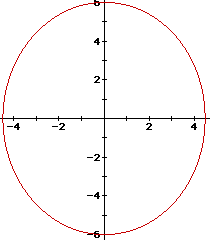 .
.
 .
.

 .
.
 .
.
 .
.
Now let us think about the definition of an ellipse a little more in-depth.
This definition makes note that the sum of two distances is a constant. This constant is refered to as k or the focal constant. One would think then that if we were given the coordinates of the foci for an ellipse and the focal constant, we could derive an equation for the ellipse. This is a correct assumption. In order to derive this equation, one needs to know the distance formula. The distance formula lets one find the distance between two points in the plane. If we are given the points (x,y) and (a,b), the distance between these two points is equal to the sqrt((x-a)2 + (y-b)2). Therefore, if we are given that the focal constant is k and the foci are at the points (a,b) and (c,d), then the set of all points (x,y) that when you sum the distances from (a,b) to (x,y) and (c,d) to (x,y) that are equal to the focal constant k, is the locus of points of the ellipse with foci at (a,b) and (c,d) and a focal constant of k.
How would you go about deriving the equation of the ellipse if all you were given was the coordinates of the foci and the focal constant?
 .
.
 .
.

 .
.
 .
.
 .
.
The graph of this equation would look like